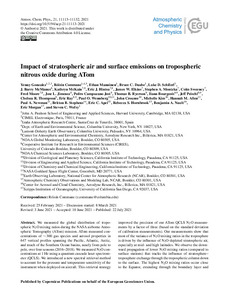Por favor, use este identificador para citar o enlazar este ítem:
http://hdl.handle.net/20.500.11765/13199
Impact of stratospheric air and surface emissions on tropospheric nitrous oxide during ATom
| Título : | Impact of stratospheric air and surface emissions on tropospheric nitrous oxide during ATom |
| Autor : | González Ramos, Yenny

|
| Palabras clave : | Greenhouse gas; Stratospheric air; Tropospheric nitrous oxide |
| Fecha de publicación : | 2021 |
| Editor: | European Geosciences Union |
| Citación : | Atmospheric Chemistry and Physics. 2021, 21(14), p. 11113–11132 |
| Versión del editor: | https://doi.org/10.5194/acp-21-11113-2021 |
| Resumen : | We measured the global distribution of tropospheric N2O mixing ratios during the NASA airborne Atmospheric Tomography (ATom) mission. ATom measured concentrations of ∼ 300 gas species and aerosol properties in 647 vertical profiles spanning the Pacific, Atlantic, Arctic, and much of the Southern Ocean basins, nearly from pole to pole, over four seasons (2016–2018). We measured N2O concentrations at 1 Hz using a quantum cascade laser spectrometer (QCLS). We introduced a new spectral retrieval method to account for the pressure and temperature sensitivity of the instrument when deployed on aircraft. This retrieval strategy improved the precision of our ATom QCLS N2O measurements by a factor of three (based on the standard deviation of calibration measurements). Our measurements show that most of the variance of N2O mixing ratios in the troposphere is driven by the influence of N2O-depleted stratospheric air, especially at mid- and high latitudes. We observe the downward propagation of lower N2O mixing ratios (compared to surface stations) that tracks the influence of stratosphere–troposphere exchange through the tropospheric column down to the surface. The highest N2O mixing ratios occur close to the Equator, extending through the boundary layer and free troposphere. We observed influences from a complex and diverse mixture of N2O sources, with emission source types identified using the rich suite of chemical species measured on ATom and the geographical origin calculated using an atmospheric transport model. Although ATom flights were mostly over the oceans, the most prominent N2O enhancements were associated with anthropogenic emissions, including from industry (e.g., oil and gas), urban sources, and biomass burning, especially in the tropical Atlantic outflow from Africa. Enhanced N2O mixing ratios are mostly associated with pollution-related tracers arriving from the coastal area of Nigeria. Peaks of N2O are often associated with indicators of photochemical processing, suggesting possible unexpected source processes. In most cases, the results show how difficult it is to separate the mixture of different sources in the atmosphere, which may contribute to uncertainties in the N2O global budget. The extensive data set from ATom will help improve the understanding of N2O emission processes and their representation in global models. |
| Patrocinador: | This research has been supported by the National Aeronautics and Space Administration (grant nos. NNX15AJ23G, NNX17AF54G, NNX15AG58A, NNX15AH33A, and 80NSSC19K0124) and the National Science Foundation (grant nos. 1852977, AGS-1547626, and AGS-1623745). |
| URI : | http://hdl.handle.net/20.500.11765/13199 |
| ISSN : | 1680-7316 1680-7324 |
| Colecciones: | Artículos científicos 2019-2022 |
Ficheros en este ítem:
| Fichero | Descripción | Tamaño | Formato | ||
|---|---|---|---|---|---|
| acp-21-11113-2021.pdf | 6,86 MB | Adobe PDF |  Visualizar/Abrir |
Los ítems de Arcimis están protegidos por una Licencia Creative Commons, salvo que se indique lo contrario.





